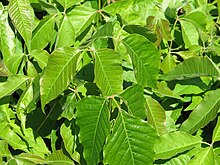Poison vine
| Toxicodendron | |
|---|---|
 |
|
 |
|
| Two pictures of Toxicodendron radicans | |
| Scientific classification | |
| Kingdom: | Plantae |
| (unranked): | Angiosperms |
| (unranked): | Eudicots |
| (unranked): | Rosids |
| Order: | Sapindales |
| Family: | Anacardiaceae |
| Subfamily: | Anacardioideae |
| Genus: |
Toxicodendron Mill. |
| Species | |
|
See text |
|
See text
Toxicodendron is a genus of flowering plants in the sumac family, Anacardiaceae. It contains woody trees, shrubs and vines, including poison ivy, poison oak, and the lacquer tree. All members of the genus produce the skin-irritating oil urushiol, which can cause a severe allergic reaction. The generic name is derived from the Greek words (toxikos), meaning "poison," and (dendron), meaning "tree". The best known members of the genus in North America are poison ivy (T. radicans), practically ubiquitous throughout most of eastern North America, and western poison oak (T. diversilobum), similarly ubiquitous throughout much of the western part of the continent.
The genus is a member of the Rhus complex, and has at various times been categorized as being either its own genus or a sub-genus of Rhus. There is evidence which points to keeping Toxicodendron as a separate monophyletic genus, but researchers have stated that the Toxicodendron and Rhus groups are complex and require more study to be fully understood.
Plants in the genus have pinnately compound, alternate leaves and whitish or grayish drupes. They are quite variable in appearance. The leaves may have smooth, toothed or lobed edges, and all three types of leaf edge may be present in a single plant. The plants grow as creeping vines, climbing vines, shrubs, or, in the case of lacquer tree (T. vernicifluum) and poison sumac (T. vernix), as trees. While leaves of poison ivy and poison oaks usually have three leaflets, sometimes there are five or, occasionally, even seven leaflets. Leaves of poison sumac have 7–13 leaflets, and of Lacquer Tree, 7–19 leaflets.
...
Wikipedia
